How to Can Beef With a Pressure Cooker
This post may contain affiliate links, view our disclosure policy for details.

Jump to Recipe
In this post, we will learn how to can meat. Canning meat is an easy way to preserve your meat without the need for refrigeration. If you hunt or if you grow and raise some of your food you probably know how important freezer space is. Canning meat is an easy way to free some of this freezer space. The meat is also softened in the process and ready to be added to any recipe!
Hunting season is in full swing here in the south and I am enjoying it so much even though I am not out there hunting myself (this is completely on the top of my list of things to learn how to do!).
I really believe that meat you harvest from nature is the healthiest meat you can possibly eat. Hunting, in my opinion, is the best way to source your food.
Even if I try to feed my farm animals the best diet I can afford, I would still never be able to do as good as nature does. Not only that, I love that the animal was free to roam around instead of being fenced. I also love that the animal had the option of choosing what it wanted to eat and when.
This year, I rely on my amazing neighbors (cause I'm now divorced) to supply me with some meat and so far I've been able to put about 20 pounds of meat away.
How to Can Meat…

Since I have this amazing meat coming right from nature, I've started exploring ways to preserve it other than just packing it and freezing it.
There is nothing wrong with freezing meat, of course. In fact, I still have venison from two years ago in my freezer, but sometimes freezer space is in high demand on the homestead with the garden going and the chickens and ducks multiplying that I felt like it was a good idea to learn how to can meat.
I love canning. I know it might be a bit intimidating at the beginning but once you get the basics down it's kinda the same process for everything.
Meat is a low-acid food, therefore, when canning meat you must use a pressure canner. This might be intimidating for some people, it definitely was for me at the beginning, but it's really not a big deal and I'll show you step-by-step how to do this.
Here is what we are going to go over…
- Reasons to can meat.
- What kind of meat can we can?
- Raw pack vs. hot pack.
- Preparing the meat.
- Packing the jars with meat.
- Adding liquid before canning meat.
- Processing meat in the pressure canner.
- Storing canned meat.
Reasons Can Meat…
Free up some freezer space – like I said above, if you have other things that need to go in the freezer (like potatoes, carrots, or leeks), or other meat you raise on the homestead (like chickens and ducks) you might want to can some of your meat to free up some freezer space.
Don't depend on electricity – if you are living off the grid you'll want to learn how to can meat. Or maybe you live out in the country and electricity goes out often and doesn't come back quickly, then it might be smart to can at least some of your meat.
If you are a preparer and want to make sure you have a supply of food that will last awhile, canning meat can be a great solution and addition to your stash of food.
The meat is softened in the process – if you raise animals for meat or if you hunt, you know that most of those animals actually moved before they were butchered. I find it especially true with deer and other animals that come straight from nature.
For example, on a deer (here is how to butcher a deer on the homestead), there is almost no fat (and the fat that is there doesn't taste good so the dog gets it…) and the meat can be a little tough sometimes.
In most cases, it just tastes better if you cook it longer or pressure cook it before using it to prepare dinner (you can see the process that I follow in my recipe pulled venison wrap or my BBQ venison neck recipe).
Well, when you can your meat you have to use a pressure canner, so really your meat is already softened and ready to use in any recipe.
No need to thaw – man, I am just so bad at remembering to take things out of the freezer the night before! I don't know if there is a cure for this or not but really I've tried many things and I am still bad at this.
I love that the meat is right there on the shelf ready for me to use. I can just grab a jar, empty the liquid (or not), and use the soft meat in any recipe. It's convenient!
It's simple – I always thought that preserving meat would be a difficult job. I don't know about the other processes, like smoking or drying because I haven't tried them yet, but canning meat is super easy!
What Kind of Meat Can We Can?
We are going to concentrate on venison, beef, caribou, elk, moose, bear, and pork today.
You can learn how to can chicken and other poultry and also rabbit in my canning chicken post.
There are two ways to can meat…
Raw Pack vs. Hot Pack…
Hot pack means that you pack the meat into the jars after you cook it.
You don't have to cook it all the way, just add some oil to a pan, let it heat and once the pan is hot add the meat cubes and brown them. Then you pack your jars with the browned meat.
When you cook the meat before canning it the cubes shrink and you are able to fit more meat into each jar. Some also say that it improves the shelf life of the meat.
In the raw pack method, you simply pack the meat in the jars while it's still raw. I find that it's much easier and saves you the step of cooking the meat.
Usually, after you just butchered and processed a large animal like a deer, being able to skip even one step is as divine to a homesteader as a picnic is for ants.
So I'll take it! Raw pack it is around these parts.
How to Can Meat – The Rw Pack Method…

I came home one day and found this deer ham on the porch wrapped in a plastic bag.
Did I already say that I have the best neighbors ever?
Anyway, they went hunting and butchered the deer and brought me one of the hind legs. There were about 10 pounds of meat in just this hind leg! It was a huge deer.
I'll show you how I do this with venison, but it's the same thing for the other kinds of meat I mentioned above.
Preparing The Meat…

I start by cleaning the meat. There is a lot of this white connective tissue/film thingy on deer meat and it's very tough and gummy to eat so I try to remove as much of it as I can.
In some areas, it separates from the meat easily and in some, it's a bit more difficult. It takes some time but it's worth the effort.
If you can caribou or moose you'll probably have to do the same, but if you are canning beef or pork you might skip this step.
The bottom line is that you want your meat to be clean from any tissue or fat that you don't want.

Then I just start cutting the meat off the bone. I don't have a certain method here…
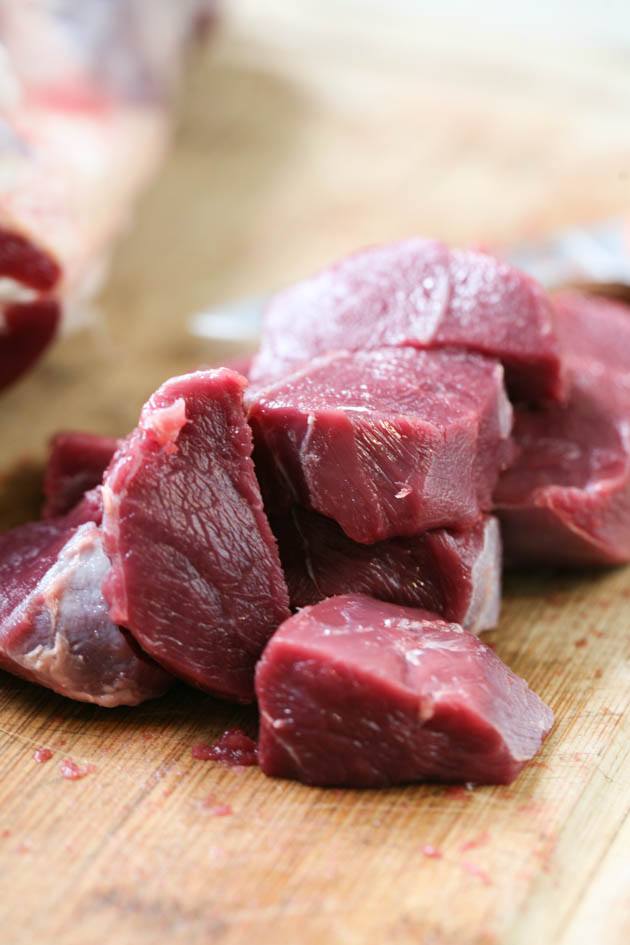
My goal is to end up with cubes that are about an inch or an inch and a half in size.
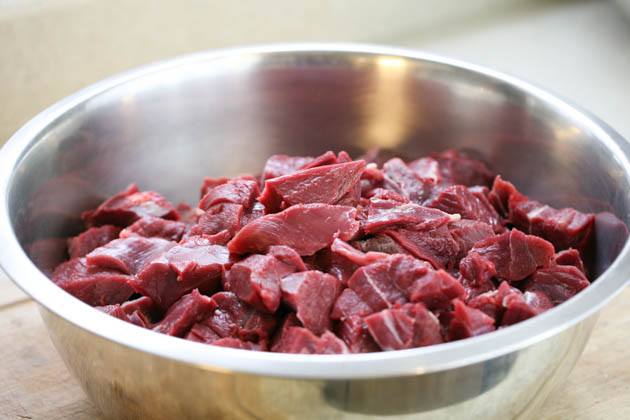
This is really the hardest part…
After a while, I wound up with a large bowl full of beautiful cubed meat. Some of it I canned and some of it became ground meat that was made into the perfect venison hamburgers.
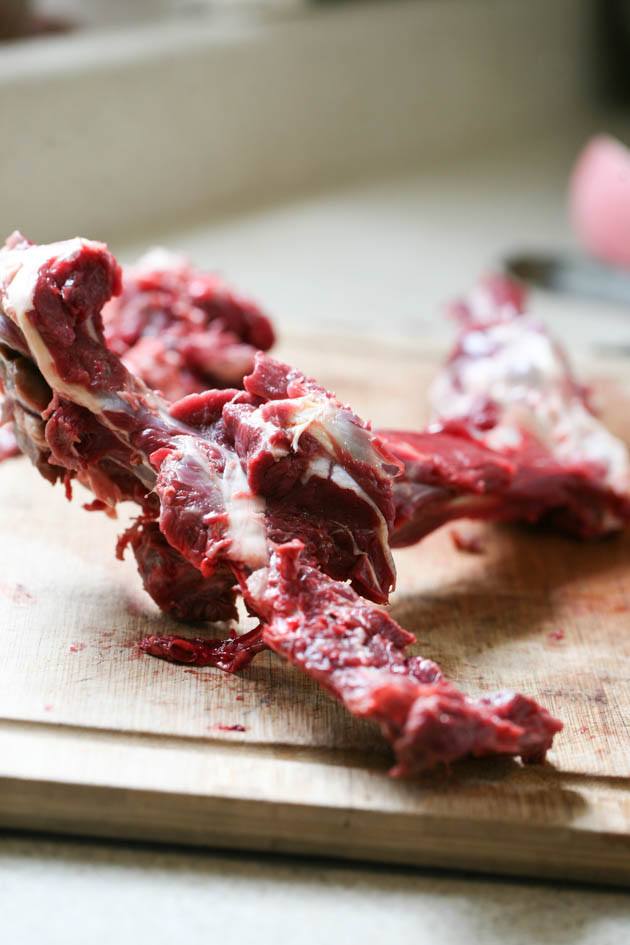
I try to get as much meat as I can off the bone.
The connective tissue that you saw above, any pieces of fat, and dirty meat (if there is any) go to the dog, the bone is going into a large pot of water to make bone broth which I will use in the canning process instead of water and seasonings. The extra bone broth I usually can.
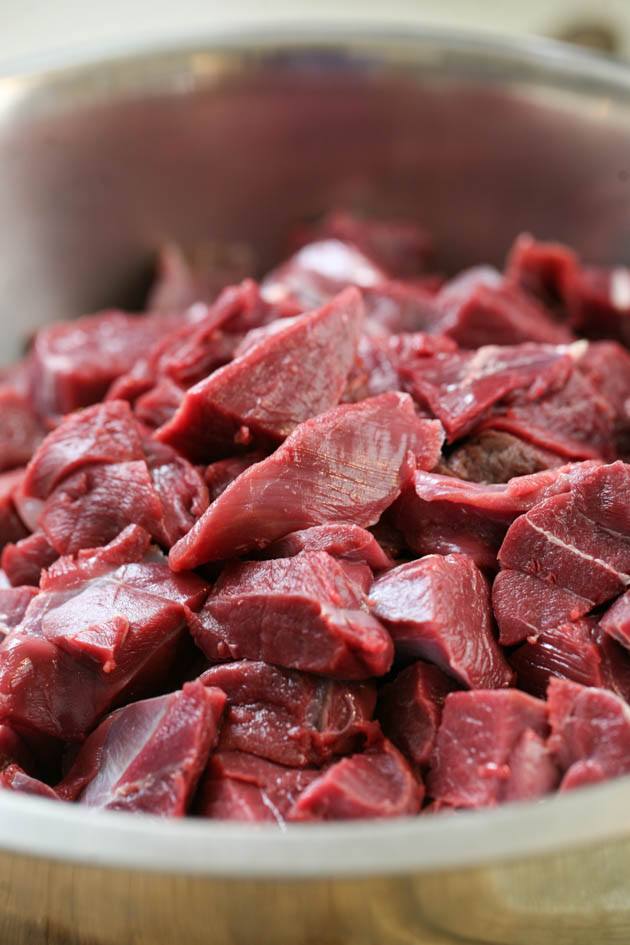
Since I wanted to use the bone broth for canning, I placed the meat in the fridge and went ahead and cooked the broth. You don't have to use broth. We will go over your options in a minute.
Packing the Jars With Meat…

When I was ready to can, I washed my quart jars with hot water and soap and placed them on the counter. I also made sure that I had new lids and rings (don't have to be new rings) to close the jars.
You don't have to sterilize anything, just make sure you wash your jars, lids, and rings with hot water and soap.
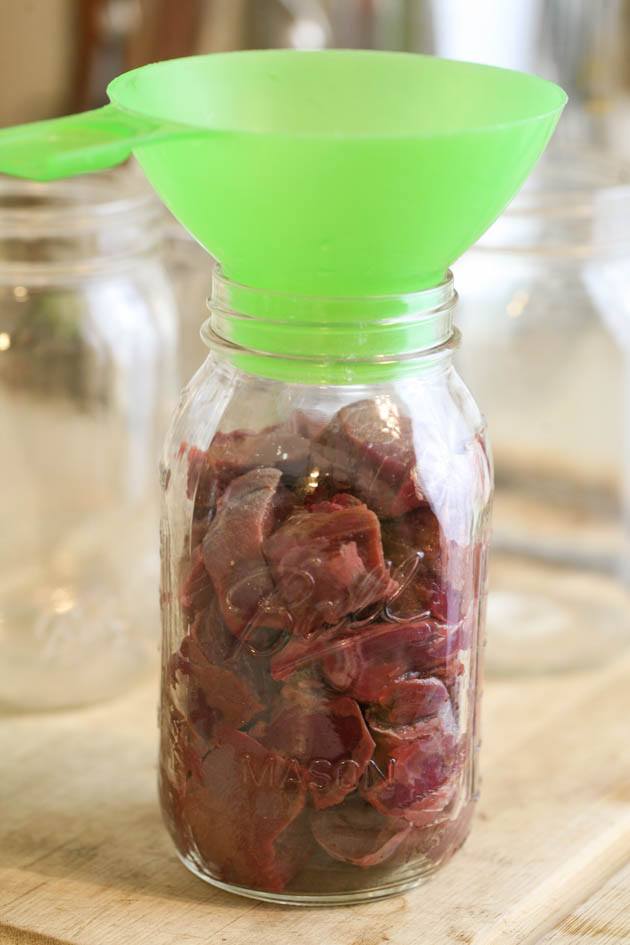
I filled each jar with the cubed meat…
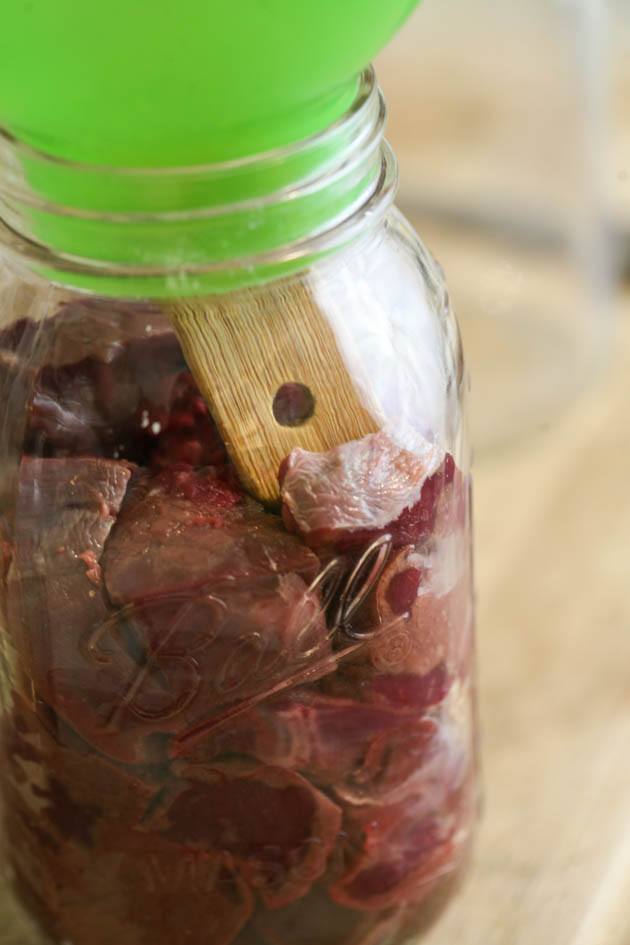
You want to pack it well in there (the meat will shrink when we pressure can it) so I used the back of a wooden spoon to kinda push it in…
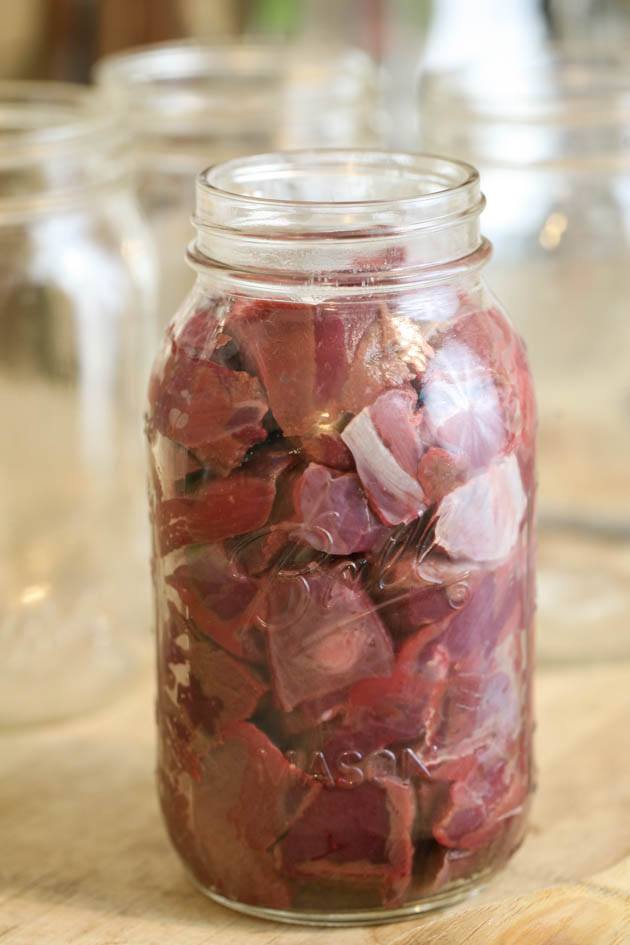
But make sure to remember to leave one-inch headspace…
Adding Liquid Before Canning Meat…
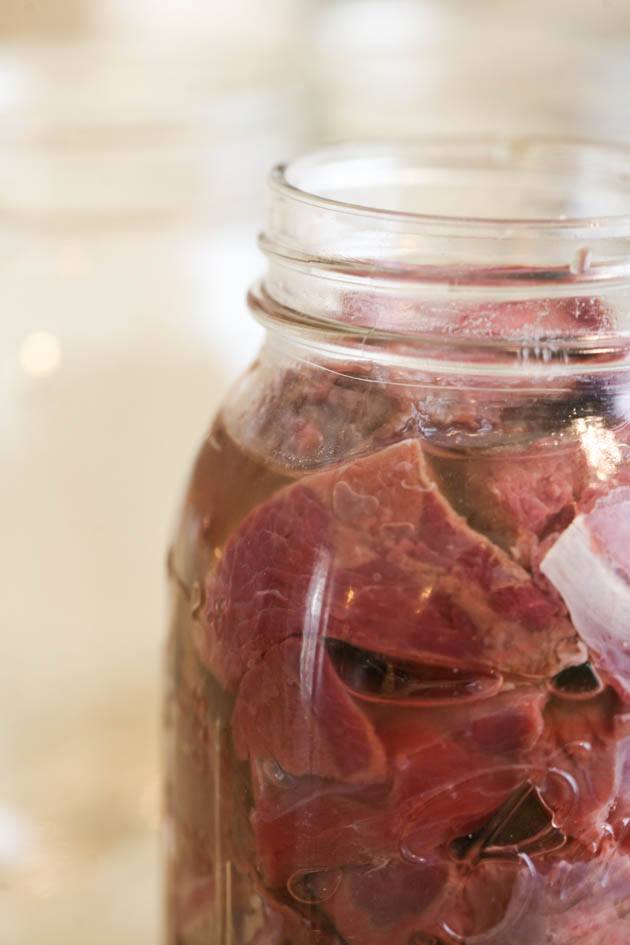
Now, let's talk about liquid, shall we?
In the raw pack method, when you process your meat in the pressure canner it will form its own liquid, so in many places, it will be advised not to add liquid at all to the jars when using the raw pack method.
I find that venison is super lean and doesn't form much liquid at all, so I personally choose to add a little bit of liquid to my jars.
You have four options…
- add just water.
- add whatever seasonings you want to the bottom of the jar (salt, peppercorns, chili flakes…) before you put the meat in it and then add water.
- use broth or stock instead of water (the broth or stock are already seasoned).
- or try to add no liquid at all (beef and pork probably don't need any liquid).
I chose to use the bone broth I made. I only added a couple of tablespoons to each quart jar.
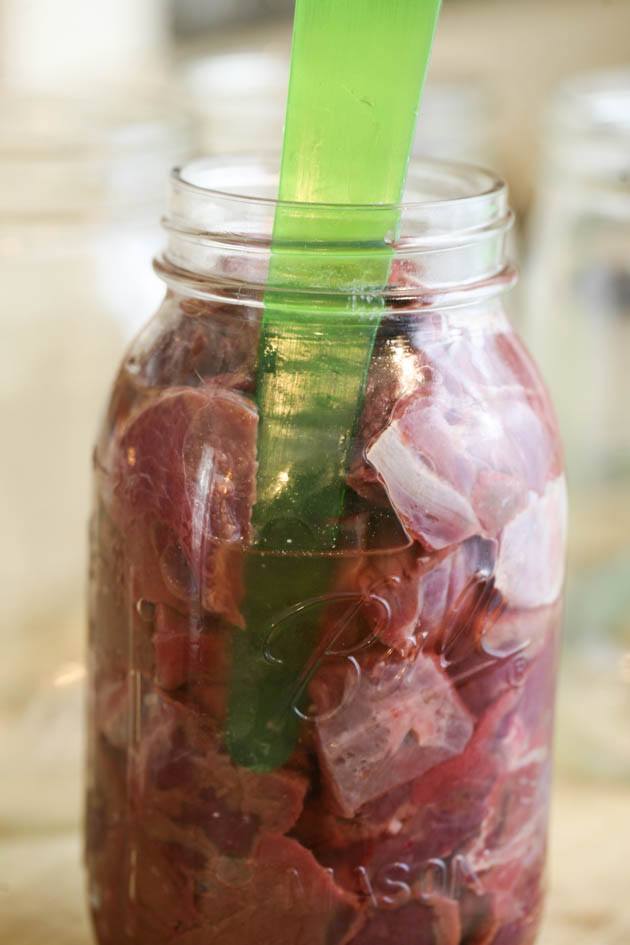
I used my bubble remover to make sure the liquid found its way to the bottom of the packed jar…
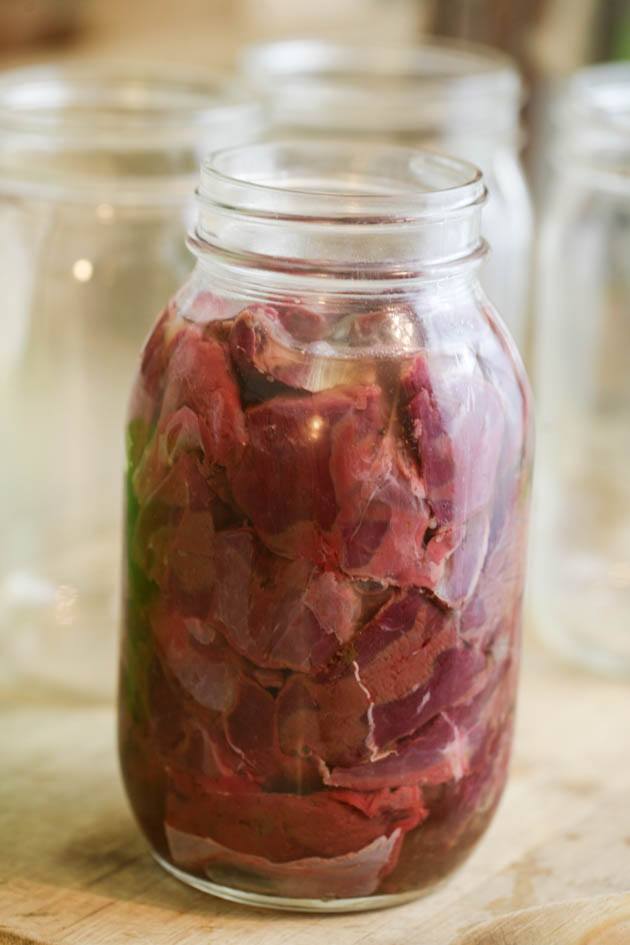
And made sure the liquid is just below the band in the jar.
This jar in the picture above actually has a little bit too much broth in it. You need to remember that the meat will form some liquid as well and we don't want the jar to overflow.
If you choose to try not to add any liquid and after you process the jars the meat is sticking out of the liquid (i.e the meat didn't form a lot of liquid…) I just want you to know that as long as your jar is sealed the meat will be fine even if it's not completely under liquid.

Next, I use a clean, damp paper towel to clean the rim of the jar…
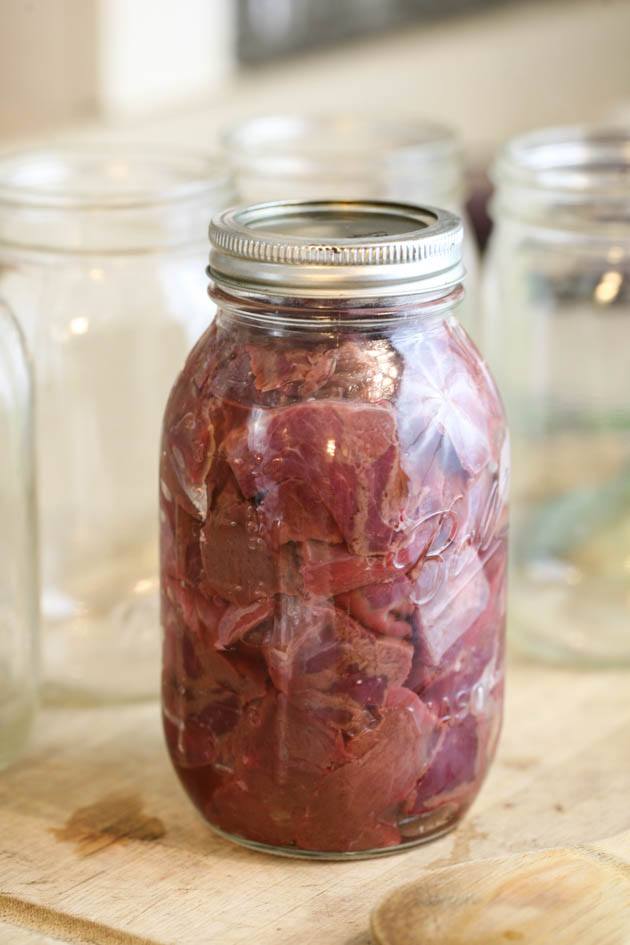
And I close it with the lid and ring, making sure to not close it too tight.
Processing Meat in the Pressure Canner…
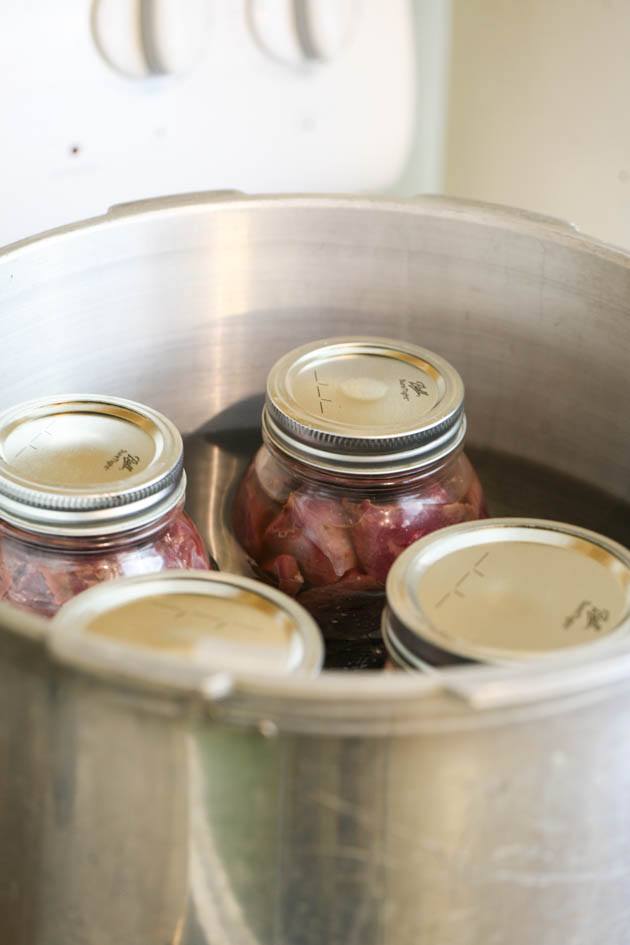
Once all your jars are filled, go ahead and place them in the pressure canner (on the rack). Mine is a Presto canner and I love it.
It's pretty simple to use (hopefully in the future I'll be able to buy me a nicer canner that can hold many more jars but for now the Presto one is great).
I'll show you how I use my canner and I am pretty sure it's a very similar process with other pressure canners but it's still important that you'll learn your canner and make sure to make any adjustments if you need to.
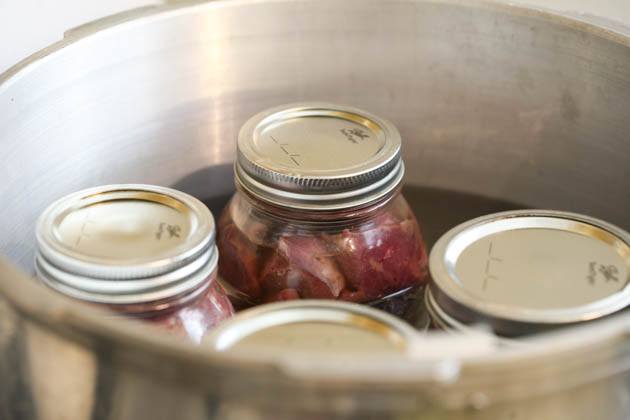
Once my jars are in the canner I add warm water to just below the band of the jars (be sure to follow the instructions for your particular canner as some don't require this much water).
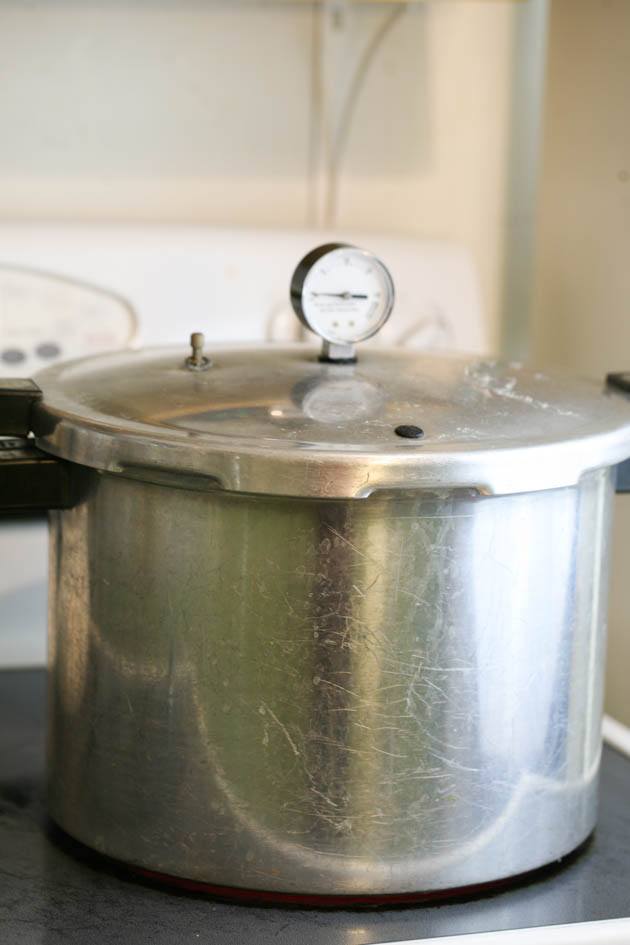
I close the canner and turn the heat on high. It usually takes between 10 to 15 minutes for steam to start coming out of the vent (notice that the weight is not on the vent yet).
Once you see steam coming out, set the timer to 10 minutes, and allow the canner to vent.
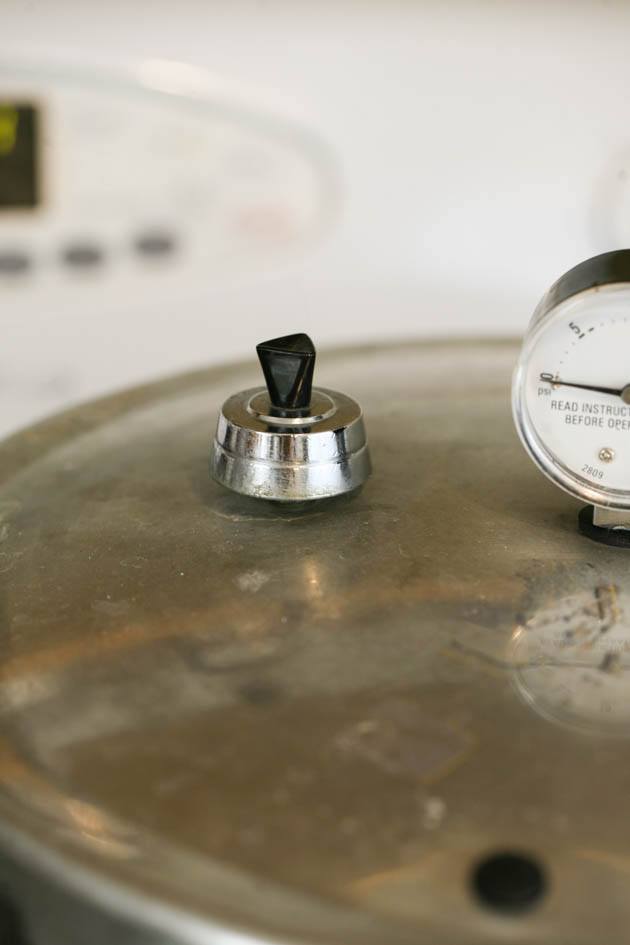
After 10 minutes of venting steam, I place the weight on the vent and watch the dial.
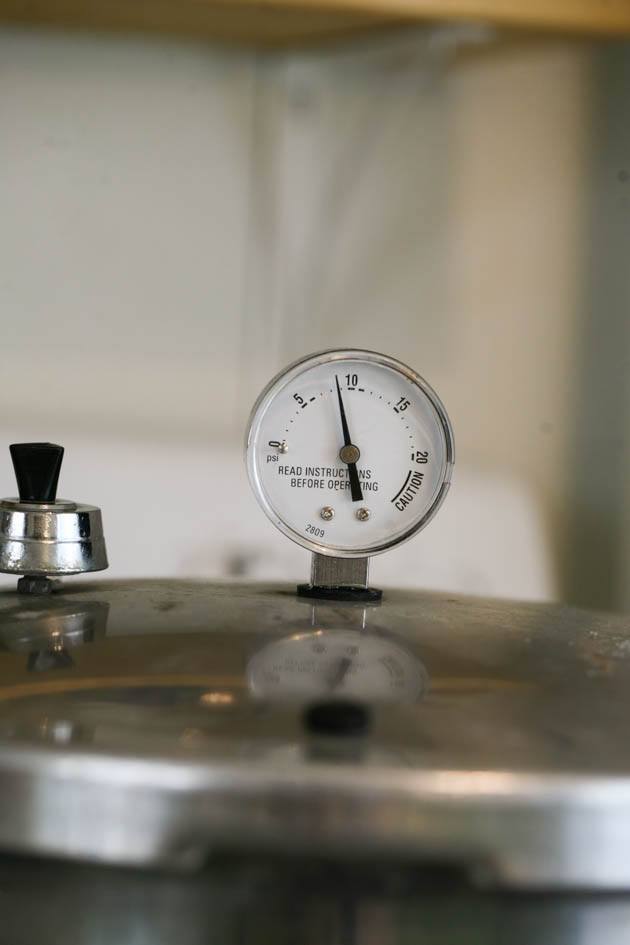
I live under 1000 ft in elevation so I wait for my dial to reach 11 psi (I use a dial gauge canner) before placing the weight on the vent.
I set the timer for the processing from the moment I put the weight on the vent.
The National Center for Home Food Preservation will tell you to process pint jars for 75 minutes and quart jars for 90 minutes.
Some say that around an hour is enough but to be on the safe side follow the NCHFP.
If you live above 1000 ft in elivation make sure to adjust your pressure. The link to the National Center for Home Food Preservation above will take you to a table that will list pressure adjustment requirements but you can also find them in the table below…
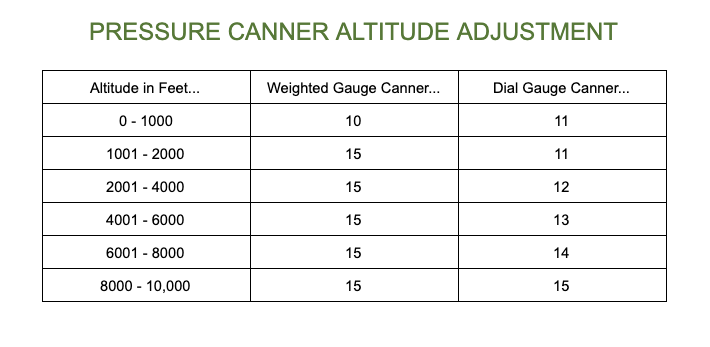
Storing Canned Meat…
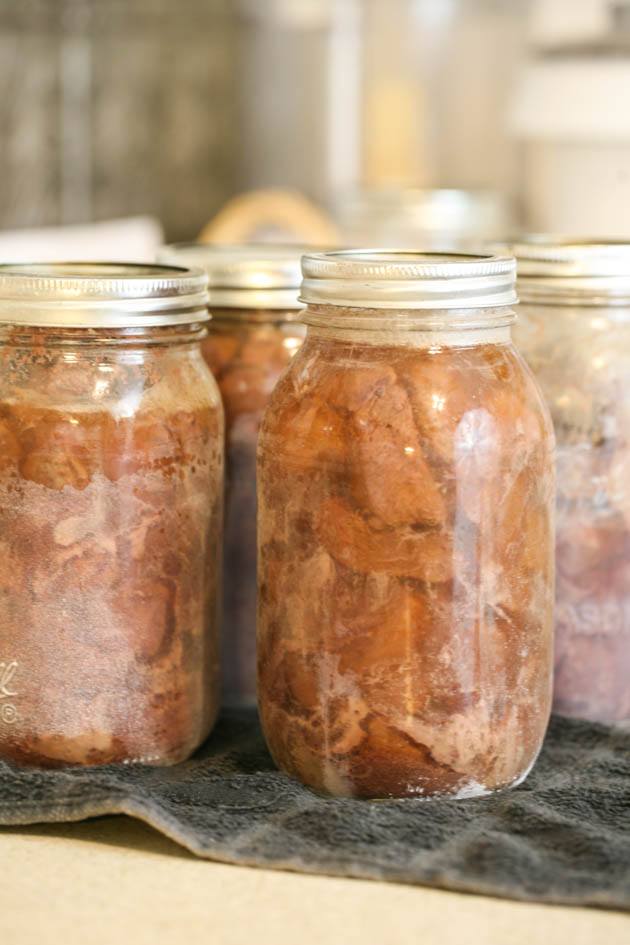
Once the time is up, turn the heat off and let your canner cool completely before trying to open it (this can take a couple of hours).
Once it has cooled, open the lid and let the jars stay in the hot water for 5-10 minutes.
Then, use the jar lifters to remove the jars. Set your jars on a towel on the counter and let them cool completely for at least 12 hours (I usually leave them overnight).
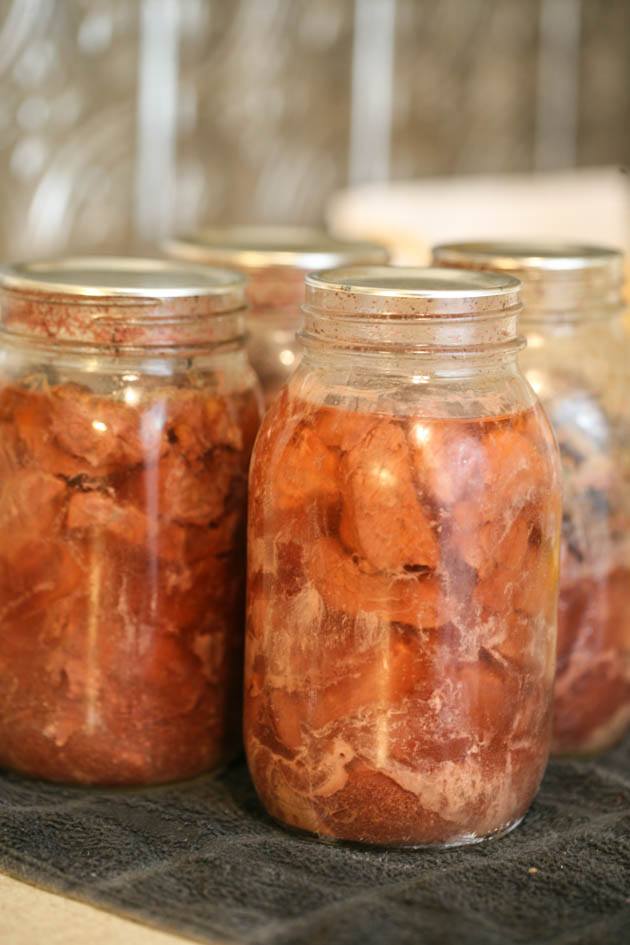
When they are cooled, check that all the jars have sealed by pressing on the lid. If there is no movement the jars are sealed.
You can remove the rings and store the jars in the pantry. Removing the rings allows you to see if anything funky is going on inside the jar.
That is it! It's really a simple process that once you've done it once you'll probably do it again many times because you'll see how simple it is. The meat can stay in the jar for two years and some say even longer than that!
When you are ready to use your meat, just open the jar and use it! You can use the broth too if you'd like. This is great meat for pretty much any dish that doesn't call for ground meat and it's already soft, seasoned, and ready to go!
If you have any experience with canning meat or if you do it differently from me please comment below and share your thoughts.
If you'd like to see how the hot pack method works, Jill at The Prairie Homestead has a great post showing the hot pack method with beef, so go check it out as well.
Here are a few more pressure canning tutorials…
How to Cam Milk
Canning Stewed Tomatoes
How to Can peppers
Canning Pea Soup
Ingredients
- Meat: elk, pork, venison, beef, bear, moose, or caribou
- Salt and other seasonings (optional)
- Water or bone broth
Instructions
- Trim and clean your meat of any unwanted parts and cut into 1'' cubes.
- Wash your jars, lids, and rings with soapy, warm water.
- If you'd like, add a teaspoon of salt to each pint jar and two teaspoons of salt to each quart jar (you can add additional seasonings like peppercorns or chili flakes if you'd like).
- Pack each jar with the cubed meat. Make sure to leave one-inch headspace.
- If you are canning venison or caribou, for example, I recommend adding a little bit of water or bone broth (2 tablespoons or so) to each jar. Pork and beef probably don't require any additional liquid.
- Clean the rim of your jars with a clean, damp paper towel.
- Cover the jars with the lids and close with the rings to fingertight.
- The following canning instructions are for a Presto pressure canner. If you have a different pressure canner, make sure to follow your manufacturer directions. Add jars to the canner (place them on the rack) so they don't touch each other.
- Fill the canner with enough water to reach just below the bend in the jar.
- Close the canner and turn the heat on high. Once steam starts to come out of the vent set your timer to 10 minutes.
- After 10 minutes, cover the vent with the weight and watch the dial. Once it reaches 11 psi (you can find the adjustment table in the notes below) adjust the temperature to hold the pressure.
- Process pint jars for 75 minutes and quart jars for 90 minutes.
- Once the time is up, turn off the heat and let your canner cool slowly.
- When the canner is cool, open it and let the jars rest in the hot water for 5-10 minutes. Then, use the jar lifters to remove the jars. Set your jars on a kitchen towel on the kitchen counter for 12 hours to cool completely.
- Make sure to check that the jars sealed and remove the rings before storing the jars.
Notes
You can follow the same process when canning venison, elk, caribou, moose, bear, pork, or beef.
Some people always add salt but it's optional and is only added for taste. If you choose to add salt, add one teaspoon to each pint jar or two teaspoons to each quart jar before you pack the meat in the jar.
If you live above 1000 feet in elevation, make sure to adjust your pressure according to the table below...


Hi! I'm Lady Lee. I help homesteaders simplify their homesteading journey while still producing a ton of food! I am a single mother of four, I was born in Israel and raised in an agricultural commune called a Kibbutz. Now I homestead in central NC.
Source: https://ladyleeshome.com/how-to-can-meat/
0 Response to "How to Can Beef With a Pressure Cooker"
Post a Comment